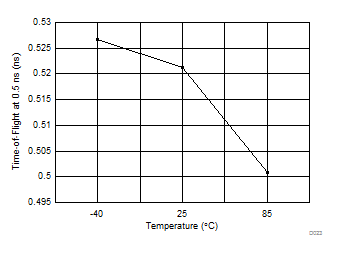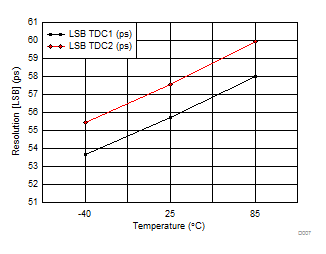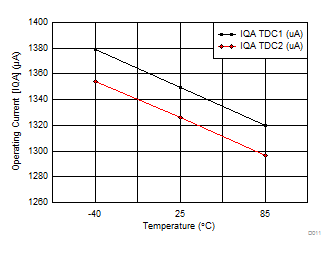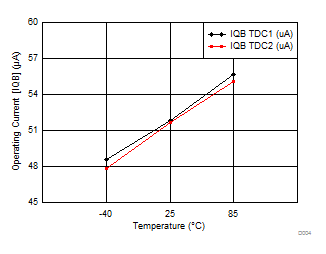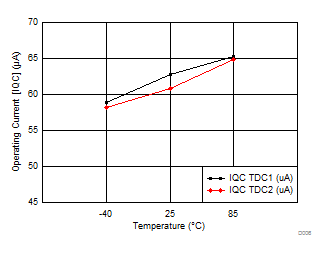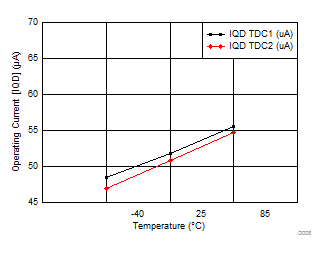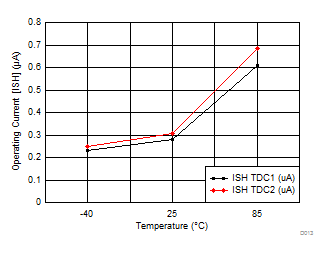SNAS686 May 2016 TDC7201
PRODUCTION DATA.
- 1 Features
- 2 Applications
- 3 Description
- 4 Revision History
- 5 Pin Configuration and Functions
- 6 Specifications
-
7 Detailed Description
- 7.1 Overview
- 7.2 Functional Block Diagram
- 7.3 Feature Description
- 7.4 Device Functional Modes
- 7.5 Programming
- 7.6
Register Maps
- 7.6.1 Register Initialization
- 7.6.2 TDCx_CONFIG1: TDCx Configuration Register 1 R/W (address = 00h, CSBx asserted) [reset = 0h]
- 7.6.3 TDCx_CONFIG2: TDCx Configuration Register 2 R/W (address = 01h, CSBx asserted) [reset = 40h]
- 7.6.4 TDCx_INT_STATUS: Interrupt Status Register (address = 02h, CSBx asserted) [reset = 00h]
- 7.6.5 TDCx_INT_MASK: TDCx Interrupt Mask Register R/W (address = 03h, CSBx asserted) [reset = 07h]
- 7.6.6 TDCx_COARSE_CNTR_OVF_H: Coarse Counter Overflow High Value Register (address = 04h, CSBx asserted) [reset = FFh]
- 7.6.7 TDCx_COARSE_CNTR_OVF_L: TDCx Coarse Counter Overflow Low Value Register (address = 05h, CSBx asserted) [reset = FFh ]
- 7.6.8 TDCx_CLOCK_CNTR_OVF_H: Clock Counter Overflow High Register (address = 06h, CSBx asserted) [reset = FFh]
- 7.6.9 TDCx_CLOCK_CNTR_OVF_L: Clock Counter Overflow Low Register (address = 07h, CSBx asserted) [reset = FFh]
- 7.6.10 TDCx_CLOCK_CNTR_STOP_MASK_H: CLOCK Counter STOP Mask High Value Register (address = 08h, CSBx asserted) [reset = 00h]
- 7.6.11 TDCx_CLOCK_CNTR_STOP_MASK_L: CLOCK Counter STOP Mask Low Value Register (address = 09h, CSBx asserted) [reset = 00h]
- 7.6.12 TDCx_TIME1: Time 1 Register (address: 10h, CSBx asserted) [reset = 00_0000h]
- 7.6.13 TDCx_CLOCK_COUNT1: Clock Count Register (address: 11h, CSBx asserted) [reset = 00_0000h]
- 7.6.14 TDCx_TIME2: Time 2 Register (address: 12h, CSBx asserted) [reset = 00_0000h]
- 7.6.15 TDCx_CLOCK_COUNT2: Clock Count Register (address: 13h, CSBx asserted) [reset = 00_0000h]
- 7.6.16 TDCx_TIME3: Time 3 Register (address: 14h, CSBx asserted) [reset = 00_0000h]
- 7.6.17 TDCx_CLOCK_COUNT3: Clock Count Registers (address: 15h, CSBx asserted) [reset = 00_0000h]
- 7.6.18 TDCx_TIME4: Time 4 Register (address: 16h, CSBx asserted) [reset = 00_0000h]
- 7.6.19 TDCx_CLOCK_COUNT4: Clock Count Register (address: 17h, CSBx asserted) [reset = 00_0000h]
- 7.6.20 TDCx_TIME5: Time 5 Register (address: 18h, CSBx asserted) [reset = 00_0000h]
- 7.6.21 TDCx_CLOCK_COUNT5: Clock Count Register (address: 19h, CSBx asserted) [reset = 00_0000h]
- 7.6.22 TDCx_TIME6: Time 6 Register (address: 1Ah, CSBx asserted) [reset = 00_0000h]
- 7.6.23 TDCx_CALIBRATION1: Calibration 1 Register (address: 1Bh, CSBx asserted) [reset = 00_0000h]
- 7.6.24 TDCx_CALIBRATION2: Calibration 2 Register (address: 1Ch, CSBx asserted) [reset = 00_0000h]
- 8 Application and Implementation
- 9 Power Supply Recommendations
- 10Layout
- 11Device and Documentation Support
- 12Mechanical, Packaging, and Orderable Information
Package Options
Mechanical Data (Package|Pins)
- ZAX|25
Thermal pad, mechanical data (Package|Pins)
Orderable Information
6 Specifications
6.1 Absolute Maximum Ratings
at TA = 25°C , VDD1 = VDD2 = 3.3 V, GND1 = GND2 = 0 V (unless otherwise noted).(1)(2)(3)(4)(5)| MIN | MAX | UNIT | ||||
|---|---|---|---|---|---|---|
| VDD | Supply voltage | –0.3 | 3.9 | V | ||
| VI | Voltage on VREG1, VREG2 pins | –0.3 | 1.65 | V | ||
| Terminal input voltage on any other pin | –0.3 | VDD + 0.3 | ||||
| VDIFF_IN | |Voltage differential| between any two input terminals | 3.9 | V | |||
| VIN_GND_VDD | |Voltage differential| between any input terminal and GND or VDD | 3.9 | V | |||
| II | Input current at any pin | –5 | 5 | mA | ||
| TA | Ambient temperature | –40 | 125 | °C | ||
| Tstg | Storage temperature | –55 | 150 | °C | ||
(1) Stresses beyond those listed under Absolute Maximum Ratings may cause permanent damage to the device. These are stress ratings only, which do not imply functional operation of the device at these or any other conditions beyond those indicated under Recommended Operating Conditions. Exposure to absolute-maximum-rated conditions for extended periods may affect device reliability.
(2) The algebraic convention, whereby the most negative value is a minimum and the most positive value is a maximum
(3) All voltages are with respect to ground, unless otherwise specified.
(4) Pins VDD1 and VDD2 must be tied together at the board level and supplied from the same source.
(5) When the terminal input voltage (VI) at any pin exceeds power supplies (VI < GND or VI > VDD), the current at that pin must not exceed 5 mA (source or sink), and the voltage (VI) at the pin must not exceed 3.9 V.
6.2 ESD Ratings
| VALUE | UNIT | |||
|---|---|---|---|---|
| V(ESD) | Electrostatic discharge | Human-body model (HBM), per ANSI/ESDA/JEDEC JS-001(1) | ±1000 | V |
| Charged-device model (CDM), per JEDEC specification JESD22-C101(2) | ±250 | |||
(1) JEDEC document JEP155 states that 500-V HBM allows safe manufacturing with a standard ESD control process.
(2) JEDEC document JEP157 states that 250-V CDM allows safe manufacturing with a standard ESD control process.
6.3 Recommended Operating Conditions
At TA = 25°C , VDD1 = VDD2 = 3.3 V, GND1 = GND2 = 0 V (unless otherwise noted).| MIN | NOM | MAX | UNIT | ||
|---|---|---|---|---|---|
| VDD | Supply voltage | 2 | 3.6 | V | |
| VI | Terminal voltage | 0 | VDD | V | |
| VIH | Voltage input high | 0.7 × VDD | 3.6 | V | |
| VIL | Voltage input low | 0 | 0.3 × VDD | V | |
| FCALIB_CLK | Frequency (reference or calibration clock) | 1 (1) | 8 | 16 | MHz |
| tCLOCK | Time period (reference or calibration clock) | 62.5 | 125 | 1000 | ns |
| DUTYCLOCK | Input clock duty cycle | 50% | |||
| TIMING REQUIREMENTS: Measurement Mode 1(1)(2)(3) | |||||
| T1Min_STARTSTOP | Minimum time between start and stop signal | 12 | ns | ||
| T1Max_STARTSTOP | Maximum time between start and stop signal | 2000 | ns | ||
| T1Min_STOPSTOP | Minimum time between 2 stop signals | 67 | ns | ||
| T1Max_LASTSTOP | Maximum time between start and last stop signal | 2000 | ns | ||
| TIMING REQUIREMENTS: Measurement Mode 2(1)(2)(3) | |||||
| T2Min_STARTSTOP | Minimum time between start and stop signal | 2 × tCLOCK | s | ||
| T2Max_STARTSTOP | Maximum time between start and stop signal | (216-2) × tCLOCK | s | ||
| T2Min_STOPSTOP | Minimum time between 2 stop signals | 2 × tCLOCK | s | ||
| T2Max_LASTSTOP | Maximum time between start and last stop signal | (216-2) × tCLOCK | s | ||
| TIMING REQUIREMENTS: ENABLE INPUT | |||||
| TREN | Rise time for enable signal (20% to 80%) | 1 to 100 | ns | ||
| TFEN | Fall time for enable signal (20% to 80%) | 1 to 100 | ns | ||
| TIMING REQUIREMENTS: START1, STOP1, CLOCK, START2, STOP2 | |||||
| TRST, TFST | Maximum rise, fall time for START, STOP signals (20% to 80%) |
1 | ns | ||
| TRXCLK, TFXCLK | Maximum rise, fall time for external CLOCK (20% to 80%) |
1 | ns | ||
| TIMING REQUIREMENTS: TRIGG1, TRIGG2 | |||||
| TTRIG1START1 | Time from TRIG1 to START1 | 5 | ns | ||
| TTRIG2START2 | Time from TRIG2 to START2 | 5 | ns | ||
| TIMING REQUIREMENTS: Measurement Mode 1 Combined Operation(4) | |||||
| T1STARTSTOP_Comb_Min | Minimum time between START and STOP signal combined | 0.25 | ns | ||
| TEMPERATURE | |||||
| TA | Ambient temperature | –40 | 85 | °C | |
| TJ | Junction temperature | –40 | 85 | °C | |
(1) Specified by design.
(2) Applies to both pairs of START1, STOP1 and START2, STOP2 pins.
(3) Minimum time between 2 stop signals applies to 2 stop signals on the same TDC.
(4) TDC7201 device in combined measurement mode where START1 and START2 are connected together:
- A common REFERENCE_START signal is applied to START1 and START2 at least 12 ns before occurrence of actual START and STOP signals in Mode 1 (and at least 2 × tCLOCK before occurrence of actual Start and Stop signals in Mode 2).
- Start signal is connected to STOP1
- Stop signal is connected to STOP2
- Two time periods T1 (REFERENCE_START to Start) and T2 (REFERENCE_START to Stop) are measured and their difference (T2-T1) is the time between Start to Stop
6.4 Thermal Information
| THERMAL METRIC(1) | TDC7201 | UNIT | |
|---|---|---|---|
| ZAX (nFBGA) | |||
| 25 PINS | |||
| RθJA | Junction-to-ambient thermal resistance | 155.1 | °C/W |
| RθJC(top) | Junction-to-case (top) thermal resistance | 109.5 | °C/W |
| RθJB | Junction-to-board thermal resistance | 114.1 | °C/W |
| ψJT | Junction-to-top characterization parameter | 20.8 | °C/W |
| ψJB | Junction-to-board characterization parameter | 110.6 | °C/W |
(1) For more information about traditional and new thermal metrics, see the Semiconductor and IC Package Thermal Metrics application report, SPRA953.
6.5 Electrical Characteristics
TA = 25°C , VDD1 = VDD2 = 3.3 V, GND1 = GND2 = 0 V (unless otherwise noted).| PARAMETER | TEST CONDITIONS | MIN | TYP | MAX | UNIT | |||
|---|---|---|---|---|---|---|---|---|
| TDC CHARACTERISTICS | ||||||||
| LSB | Resolution | Single shot measurement | 55 | ps | ||||
| TACC-2 | Accuracy (Mode 2)(1) | CLOCK = 8 MHz, Jitter (RMS) < 1 ps, Stability < 5 ppm | 28 | ps | ||||
| TSTD-2 | Standard Deviation (Mode 2) | Measured time = 100 µs | 50 | ps | ||||
| Measured time = 1 µs | 35 | ps | ||||||
| OUTPUT CHARACTERISTICS: TRIGG1, TRIGG2, INTB1, INTB2, DOUT1, DOUT2 | ||||||||
| VOH | Output voltage high | Isource = –2 mA | 2.31 | 2.95 | V | |||
| VOL | Output voltage low | Isink = 2 mA | 0.35 | 0.99 | V | |||
| INPUT CHARACTERISTICS: START1, STOP1, START2, STOP2, CSB1, CSB2 | ||||||||
| Cin | Input capacitance(2) | 4 | pF | |||||
| INPUT CHARACTERISTICS: ENABLE, CLOCK, DIN, SCLK | ||||||||
| Cin | Input capacitance(2) | 8 | pF | |||||
| POWER CONSUMPTION(3) (see Measurement Mode 1 and Measurement Mode 2) | ||||||||
| Ish | Shutdown current | EN = LOW | 0.6 | µA | ||||
| IQA | Quiescent Current A | EN = HIGH; TDC running | 2.7 | mA | ||||
| IQB | Quiescent Current B | EN = HIGH; TDC OFF, Clock Counter running | 140 | µA | ||||
| IQC | Quiescent Current C | EN = HIGH; measurement stopped, SPI communication only | 175 | µA | ||||
| IQD | Quiescent Current D | EN = HIGH, TDC OFF, counter stopped, no communication | 100 | µA | ||||
(1) Accuracy is defined as the systematic error in the output signal; the error of the device excluding noise.
(2) Specified by design.
(3) Sum of TDC1 and TDC2 values
6.6 Timing Requirements
| MIN | NOM | MAX | UNIT | |||
|---|---|---|---|---|---|---|
| TIMING REQUIREMENTS: START1, STOP1, START2, STOP2, CLOCK | ||||||
| PWSTART | Pulse width for Start Signal | 10 | ns | |||
| PWSTOP | Pulse width for Stop Signal | 10 | ns | |||
| SERIAL INTERFACE TIMING CHARACTERISTICS (VDD = 3.3 V, fSCLK = 25 MHz) (See Figure 1) | ||||||
| fSCLK | SCLK frequency | 25 | MHz | |||
| t1 | SCLK period | 40 | ns | |||
| SERIAL INTERFACE TIMING CHARACTERISTICS (VDD = 3.3 V, fSCLK = 20 MHz) (See Figure 1) | ||||||
| t1 | SCLK period | 50 | ns | |||
| t2 | SCLK High Time | 16 | ns | |||
| t3 | SCLK Low Time | 16 | ns | |||
| t4 | DIN setup time | 5 | ns | |||
| t5 | DIN hold time | 5 | ns | |||
| t6 | CSB1 or CSB2 fall to SCLK rise | 6 | ns | |||
| t7 | Last SCLK rising edge to CSB1 or CSB2 rising edge | 6 | ns | |||
| t8 | Minimum pause time (CSB high) | 40 | ns | |||
| t9 | Clk fall to DOUT1 or DOUT2 bus transition | 12 | ns | |||
6.7 Switching Characteristics
TA = 25°C , VDD1 = VDD2 = 3.3 V, GND1 = GND2 = 0 V (unless otherwise noted).| PARAMETER | TEST CONDITIONS | MIN | TYP | MAX | UNIT | |
|---|---|---|---|---|---|---|
| WAKE UP TIME | ||||||
| TWAKEUP_PERIOD | Time to be ready for measurement | LSB within 0.3% of settled value | 300 | µs | ||
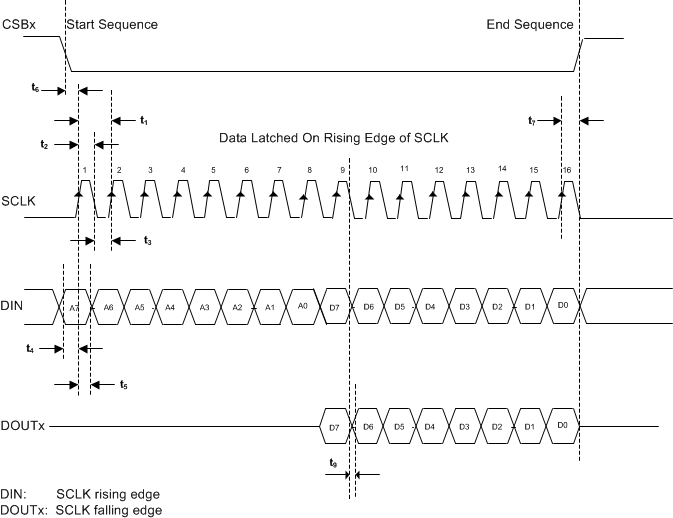 Figure 1. SPI Register Access: 8 Bit Register Example
Figure 1. SPI Register Access: 8 Bit Register Example
6.8 Typical Characteristics
At TA = 25°C , VDD1 = VDD2 = 3.3 V, GND1 = GND2 = 0 V, CLOCK = 8 MHz, CALIBRATION2_PERIODS = 10, AVG_CYCLES = 1 Measurement, NUM_STOP = Single STOP, Measurement Mode 2 (unless otherwise noted).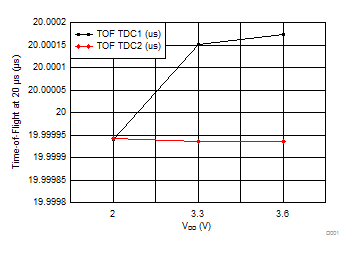
(Measurement Mode 2)
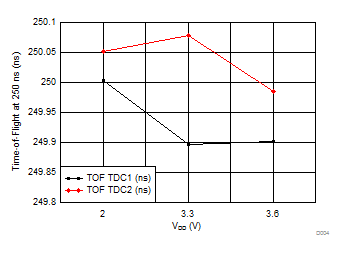
(Measurement Mode 1)
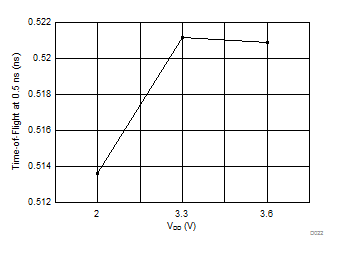
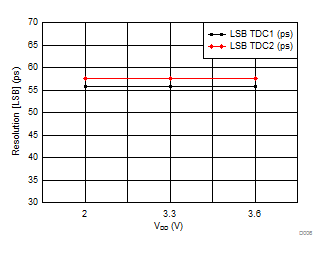
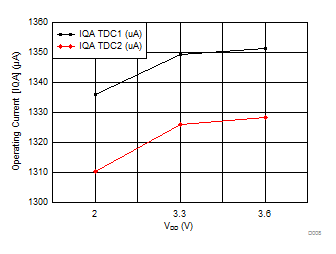
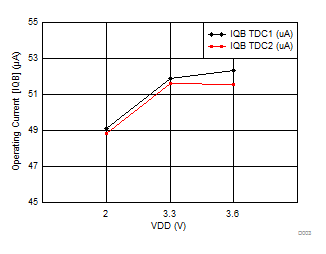
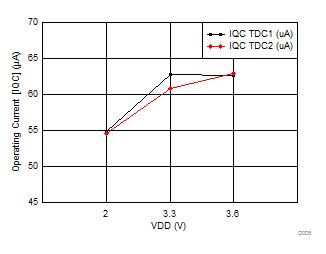
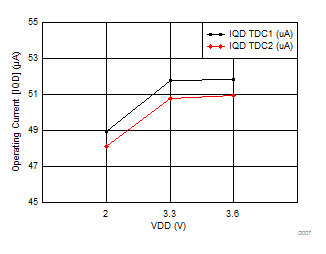
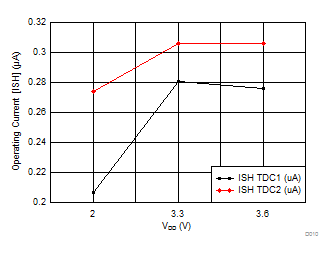
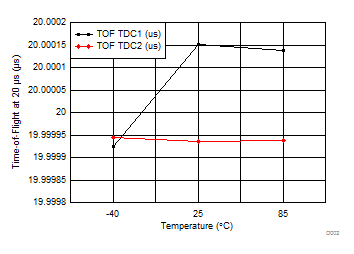
(Measurement Mode 2)
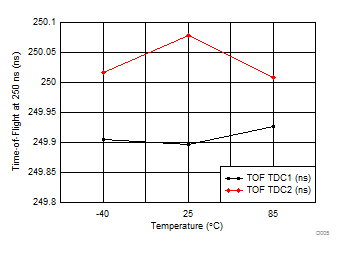
(Measurement Mode 1)
